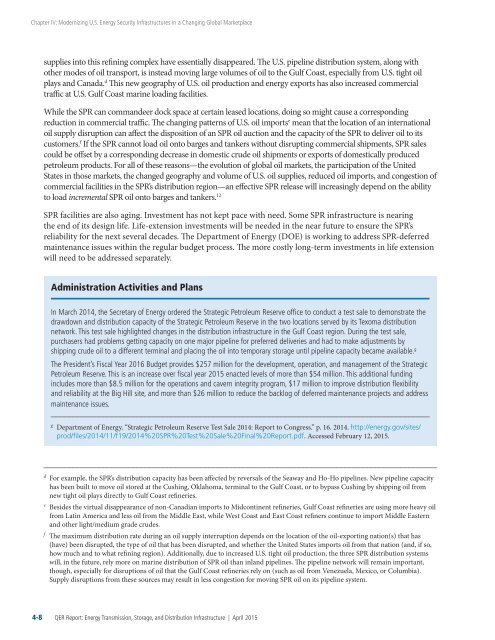LVXXU
LVXXU
LVXXU
You also want an ePaper? Increase the reach of your titles
YUMPU automatically turns print PDFs into web optimized ePapers that Google loves.
Chapter IV: Modernizing U.S. Energy Security Infrastructures in a Changing Global Marketplace<br />
supplies into this refining complex have essentially disappeared. The U.S. pipeline distribution system, along with<br />
other modes of oil transport, is instead moving large volumes of oil to the Gulf Coast, especially from U.S. tight oil<br />
plays and Canada. d This new geography of U.S. oil production and energy exports has also increased commercial<br />
traffic at U.S. Gulf Coast marine loading facilities.<br />
While the SPR can commandeer dock space at certain leased locations, doing so might cause a corresponding<br />
reduction in commercial traffic. The changing patterns of U.S. oil imports e mean that the location of an international<br />
oil supply disruption can affect the disposition of an SPR oil auction and the capacity of the SPR to deliver oil to its<br />
customers. f If the SPR cannot load oil onto barges and tankers without disrupting commercial shipments, SPR sales<br />
could be offset by a corresponding decrease in domestic crude oil shipments or exports of domestically produced<br />
petroleum products. For all of these reasons—the evolution of global oil markets, the participation of the United<br />
States in those markets, the changed geography and volume of U.S. oil supplies, reduced oil imports, and congestion of<br />
commercial facilities in the SPR’s distribution region—an effective SPR release will increasingly depend on the ability<br />
to load incremental SPR oil onto barges and tankers. 12<br />
SPR facilities are also aging. Investment has not kept pace with need. Some SPR infrastructure is nearing<br />
the end of its design life. Life-extension investments will be needed in the near future to ensure the SPR’s<br />
reliability for the next several decades. The Department of Energy (DOE) is working to address SPR-deferred<br />
maintenance issues within the regular budget process. The more costly long-term investments in life extension<br />
will need to be addressed separately.<br />
Administration Activities and Plans<br />
In March 2014, the Secretary of Energy ordered the Strategic Petroleum Reserve office to conduct a test sale to demonstrate the<br />
drawdown and distribution capacity of the Strategic Petroleum Reserve in the two locations served by its Texoma distribution<br />
network. This test sale highlighted changes in the distribution infrastructure in the Gulf Coast region. During the test sale,<br />
purchasers had problems getting capacity on one major pipeline for preferred deliveries and had to make adjustments by<br />
shipping crude oil to a different terminal and placing the oil into temporary storage until pipeline capacity became available. g<br />
The President’s Fiscal Year 2016 Budget provides $257 million for the development, operation, and management of the Strategic<br />
Petroleum Reserve. This is an increase over fiscal year 2015 enacted levels of more than $54 million. This additional funding<br />
includes more than $8.5 million for the operations and cavern integrity program, $17 million to improve distribution flexibility<br />
and reliability at the Big Hill site, and more than $26 million to reduce the backlog of deferred maintenance projects and address<br />
maintenance issues.<br />
g<br />
Department of Energy. “Strategic Petroleum Reserve Test Sale 2014: Report to Congress.” p. 16. 2014. http://energy.gov/sites/<br />
prod/files/2014/11/f19/2014%20SPR%20Test%20Sale%20Final%20Report.pdf. Accessed February 12, 2015.<br />
d<br />
For example, the SPR’s distribution capacity has been affected by reversals of the Seaway and Ho-Ho pipelines. New pipeline capacity<br />
has been built to move oil stored at the Cushing, Oklahoma, terminal to the Gulf Coast, or to bypass Cushing by shipping oil from<br />
new tight oil plays directly to Gulf Coast refineries.<br />
e<br />
Besides the virtual disappearance of non-Canadian imports to Midcontinent refineries, Gulf Coast refineries are using more heavy oil<br />
from Latin America and less oil from the Middle East, while West Coast and East Coast refiners continue to import Middle Eastern<br />
and other light/medium grade crudes.<br />
f<br />
The maximum distribution rate during an oil supply interruption depends on the location of the oil-exporting nation(s) that has<br />
(have) been disrupted, the type of oil that has been disrupted, and whether the United States imports oil from that nation (and, if so,<br />
how much and to what refining region). Additionally, due to increased U.S. tight oil production, the three SPR distribution systems<br />
will, in the future, rely more on marine distribution of SPR oil than inland pipelines. The pipeline network will remain important,<br />
though, especially for disruptions of oil that the Gulf Coast refineries rely on (such as oil from Venezuela, Mexico, or Columbia).<br />
Supply disruptions from these sources may result in less congestion for moving SPR oil on its pipeline system.<br />
4-8 QER Report: Energy Transmission, Storage, and Distribution Infrastructure | April 2015


